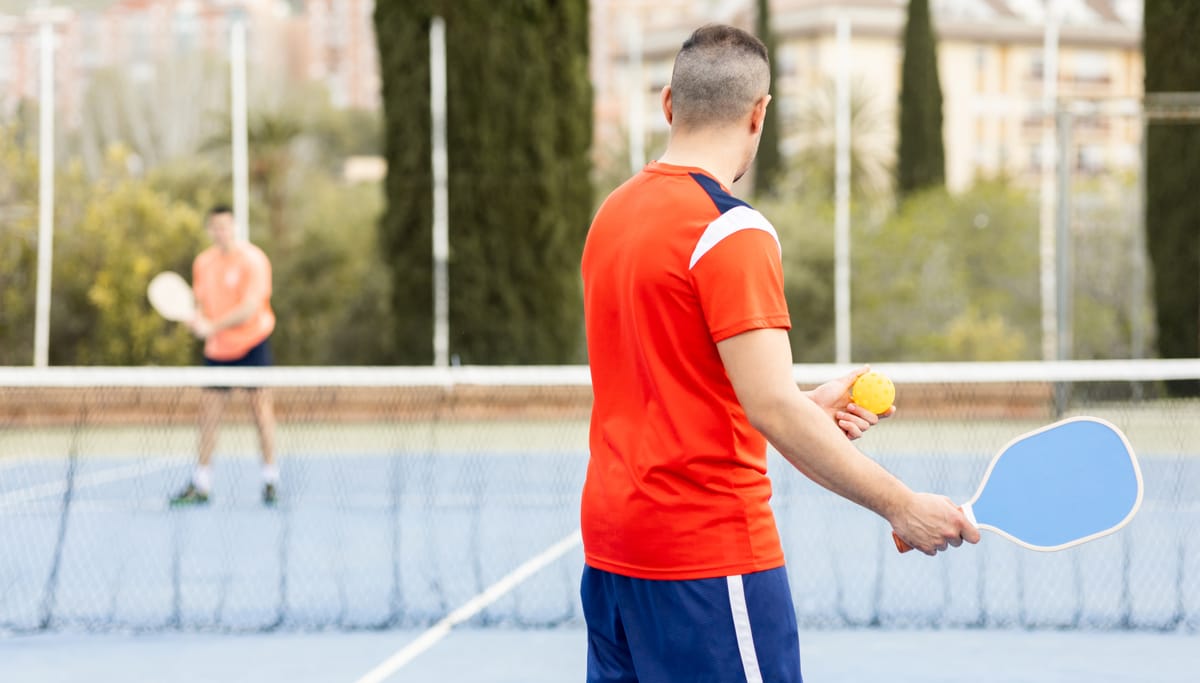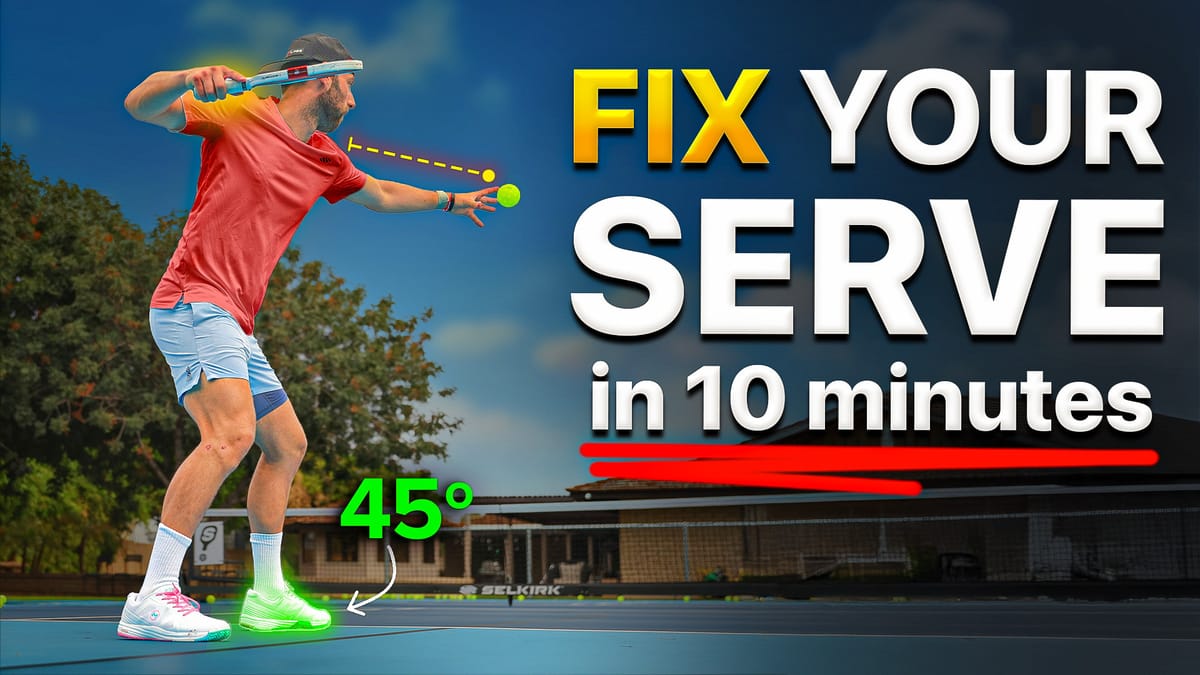
ThatPickleballSchool

Hey guys, it’s Kyle from ThatPickleballSchool. I hit the courts with Zane Navratil—one of the most game-changing servers in the sport—was so fascinating. Not only did he reshape how players approach the serve, but the rules of pickleball literally had to change because of him.
In our conversation, Zane walked me through the full evolution of his serve, the various rule changes that followed, and what he thinks is coming next for the pickleball serve. Here’s what I learned.
How the Chainsaw Serve Was Born (And Banned)
Zane explained that his earliest serve was simple—coming from a tennis background, he started with a continental grip and focused on just getting the ball in play. But it wasn’t long before he realized that was a missed opportunity.
The first major shift came around 2018 or 2019, when paddle technology evolved. With more texture on the surface, Zane switched to a semi-western grip and began brushing up the back of the ball to generate topspin.
That’s when he started experimenting with spin serves—first by spinning the ball off his paddle before hitting it. It earned the nickname “the chainsaw” because of the motion, which looked like pull-starting a chainsaw. Eventually, though, that version of the serve was banned by the PPA before he even got to use it in a tournament.

Undeterred, Zane started spinning the ball off his fingers instead. It created the same effect—more spin on the toss—and for a while, this became the dominant version of the spin serve. But in 2022, the governing bodies cracked down again. USA Pickleball banned two-handed spin tosses, while the PPA banned any spin on the toss entirely.
To keep pushing the boundaries, Zane then moved to a one-handed spin toss—snapping the ball with his fingers like Morgan Evans had done. But by the end of that year, all spin serves were outlawed.

Why Zane Focuses on Depth and Height—Not Placement
One of the most surprising things I heard from Zane was that he doesn’t believe placement matters much on the serve—especially at the highest levels.
His reasoning? If an elite opponent wants to hit a forehand return, they’ll find a way to do it—regardless of where the serve lands. Instead of trying to target a backhand and potentially overthinking placement, Zane focuses on hitting deep and with height to push opponents off the line. According to him, the main goal of the serve is to make the third shot easier—and forcing a deeper return accomplishes that.
What Zane Thinks About Open Stance vs. Closed Stance
As someone who’s tried open stance serving myself, I asked Zane to break down why some players use it and whether it’s worth the hype.
He explained that open stance often comes from tennis, where players might get pulled wide and don’t have time to step into the ball. But when it comes to serving, he sees more limitations than benefits—especially for non-pros. In his experience, open stance restricts hip rotation and leg involvement, which are key sources of power. Instead, he prefers a more closed stance that lets him load with the legs, use his hips, and step into the serve.
Interestingly, he also starts a few feet behind the baseline so he can finish his motion without drifting into the court—another detail I hadn’t thought about before. He told me he also feels he gets better height on the serve this way, which is another major emphasis in his current technique.
Learning to Take More Risk on the Serve
Something that really stuck with me was Zane’s take on risk and consistency. Most players, he said, are proud of never missing serves—but that might actually be a problem.
He made the case that no shot in pickleball should be made 100% of the time. If you’re never missing serves, you’re probably not taking enough risk to pressure your opponent. That was eye-opening for me—and something I’ll definitely be applying to my own game.

Where the Serve Is Headed Next: Game Theory and Variety
I asked Zane what he sees as the next evolution in serving now that spin serves are off the table. He said it’s not about one groundbreaking technique anymore—it’s about mixing up pace and trajectory to keep returners off balance.
In other words, game theory. Serve deep and loopy on one point, then go flat and fast on the next. The key is not giving opponents the same “pitch” every time, so they can’t get into a rhythm.
It’s a more subtle shift, but as the sport matures, those marginal gains become more and more important.
Why Zane Supports the Drop Serve
One thing Zane was very vocal about: he believes the drop serve is the only enforceable serving rule. Everything else, in his opinion, is too subjective to be policed consistently.
He’s even addressed the common critique that drop serves look awkward on TV. His counter? A drop serve can look athletic—it’s all about how you do it. He demoed one for me, and I’ll be honest… it looked pretty legit.
Final Takeaways
Talking with Zane was one of the most insightful conversations I’ve had in pickleball. He’s thoughtful, strategic, and clearly still pushing the boundaries of what’s possible—despite the constant rule changes.
Whether you agree with his takes or not, there’s no denying Zane Navratil has reshaped how we think about the serve. And based on where things are headed, he’s not done yet.
Think you know pickleball inside and out? Challenge yourself with ThatPickleball IQ Test and see if you can score a perfect 10 out of 10!
Related Articles:
Anuncie Aqui / Advertise Here
Sua marca para o mundo Pickleball! / Your brand for the Pickleball world!

 English
English  Spanish
Spanish  Portuguese
Portuguese  German
German  Italian
Italian  Japanese
Japanese  French
French  Polish
Polish  Russian
Russian  Netherlands
Netherlands  Hungarian
Hungarian  Turkish
Turkish  Videos
Videos  Pickleball Portal
Pickleball Portal









 English (US) ·
English (US) ·  Portuguese (BR) ·
Portuguese (BR) ·